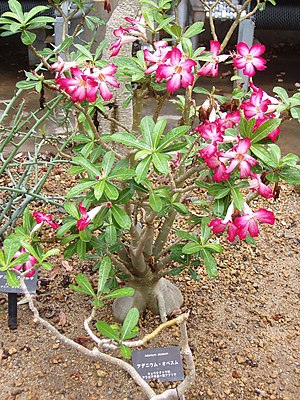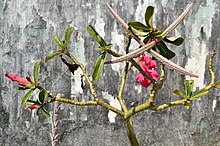Desert roses
| Desert roses | ||||||||||||
|---|---|---|---|---|---|---|---|---|---|---|---|---|

Adenium obesum ("desert rose") |
||||||||||||
| Systematics | ||||||||||||
|
||||||||||||
| Scientific name | ||||||||||||
| Adenium | ||||||||||||
| Rom. & Schult. |
The desert roses ( Adenium ) are a genus of plants from the dog venom family (Apocynaceae). Adenium obesum , also known as the "desert rose", is used as a houseplant for sunny windows; it is often grafted onto oleander for this purpose .
description

The desert roses are stem succulent almost evergreen to evergreen plants ; they grow as shrubs and form thickened stems (caudex). They can reach heights of up to 5 meters and trunk diameters of up to 2 meters. Desert rose species grow slowly and can live for several hundred years. The leaves , arranged in a spiral and heaped at the end of the shoot, are leathery, undivided and about 5 to 15 centimeters long.
Of terminal inflorescences sitting flowers . The hermaphrodite, slightly zygomorphic flowers are five-fold. The five petals are fused, they are usually pink to red in color. There are follicles formed. Strikingly, the seeds have two wreaths of flying hair, one at the top and one at the bottom.
distribution
The desert roses are native to Africa and Arabia .
They prefer to grow in a semi-arid climate.
Systematics
The desert roses ( Adenium ) are placed in the subfamily of the Apocynoideae . With further subdivision of the subfamily, the genus is assigned to the tribe Wrightieae . The first description by the botanists Johann Jacob Römer and Josef August Schultes was published in 1819.
The system within the genus was seen very differently. Sometimes four, five or up to 15 species were differentiated in the genus, but sometimes the genus was also viewed as monotypical with the only species Adenium obesum and many subspecies. According to the current list of species according to Kew Checklists, the following six species were distinguished in 2008, whereby in addition to the botanical author abbreviation, the publication with the year of publication of the first description and the area of distribution is given:
- Adenium boehmianum Schinz , Verh. Bot. Verein Prov. Brandenburg 30: 259 (1888) (Syn .: Adenium obesum subsp. Boehmianum (Schinz) GDRowley ): It occurs from southern Angola to north-western and central Namibia.
- Adenium dhofarense Rzepecky , Cact. Succ. J. (Los Angeles) 87: 131 (2015): It wasfirst describedin 2015 from southern Oman .
- Adenium multiflorum Klotzsch in WCHPeters, Naturw. Reise Mossambique 6: 279 (1861): It occurs in southern tropical and southern Africa.
- Adenium obesum (Forssk.) Roem. & Schult. - called "Desert Rose" for short -, Roemer & Schultes, Systema Vegetabilium, Volume 4: 411 (1819): The species occurs from tropical West Africa to Tanzania and the Arabian Peninsula and also on Socotra.
- Olive-leaved desert rose ( Adenium oleifolium Stapf , Bull. Misc. Inform. Kew 1907: 53 (1907), Syn .: Adenium obesum subsp. Oleifolium (Stapf) GDRowley ): It occurs in southern Africa.
- Narrow-leaved desert rose ( Adenium swazicum Stapf , Bull. Misc. Inform. Kew 1907: 53 (1907), Syn .: Adenium obesum subsp. Swazicum (Stapf) GDRowley ): It occurs from southern Mozambique to southern Africa.
In the opinion of Gordon Douglas Rowley , the above species (excluding Adenium dhofarense ) belong to the species Adenium obesum as subspecies . The genus Adenium is then monotypical. Rowley distinguishes the following subspecies:
- Ordinary Desert Rose ( Adenium obesum subsp. Obesum )
- Adenium obesum subsp. boehmianum (Schinz) GDRowley
- Ölbaumblättrige Desert Rose ( Adenium obesum subsp. Oleifolium (Stapf) GDRowley )
- Adenium obesum subsp. socotranum (Vierh.) Lavranos
- Somali desert rose ( Adenium obesum subsp. Somalense (Balf.f.) GDRowley )
- Narrow-leaved desert rose ( Adenium obesum subsp. Swazicum (Stapf) GDRowley )
Individual evidence
- ↑ K. Schumann: Apocynaceae. In: A. Engler, C. Prantl: The natural plant families ... IV. Part, 2nd section, page 177. Leipzig 1895.
- ↑ Syst. Veg., Ed. 15 to [Roemer & Schultes] 4: 35 & 411. 1819. See entry at IPNI .
- ↑ a b c d e f g Rafaël Govaerts (Ed.): Adenium. In: World Checklist of Selected Plant Families (WCSP) - The Board of Trustees of the Royal Botanic Gardens, Kew . Retrieved January 18, 2019.
- ↑ The German name "Wüstenrose" is noted in the Zander hand dictionary of plant names, 17th edition, but in this edition from 2002 the genus Adenium was regarded as monotypical.
- ↑ a b c d e f Walter Erhardt among others: The great pikeperch. Encyclopedia of Plant Names . Volume 2. Verlag Eugen Ulmer, Stuttgart 2008. ISBN 978-3-8001-5406-7
- ^ Adenium and Pachypodium Handbook . Botley 1983
- ↑ Adenium . In: Urs Eggli (Ed.): Sukkulentenlexikon Volume 2 Dicotyledonous plants (dicotyledons) with the exception of Aizoaceae, Asclepiadaceae, Cactaceae and Crassulaceae . Eugen Ulmer Verlag, Stuttgart 2002, pp. 6-8 ISBN 3-8001-3915-4
swell
- Entry at plantzafrica.com (English)
- Entry in Flora of Zimbabwe. (engl.)
- Entry at adeniumplumeria.com. (engl.)




